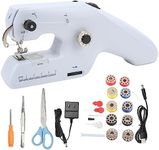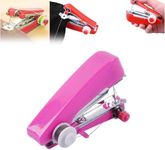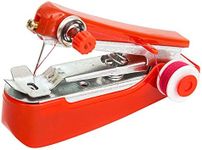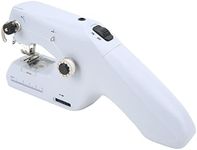Buying Guide for the Best Handheld Sewing Machines
Choosing a handheld sewing machine can be a great way to handle quick repairs, small projects, or sewing on the go. These compact devices are designed for convenience and portability, but they do have limitations compared to full-sized sewing machines. When picking the right handheld sewing machine, it's important to consider what you'll be using it for, how often you'll use it, and what types of fabrics you plan to sew. Understanding the key features will help you find a model that matches your needs and makes your sewing experience smoother and more enjoyable.Power SourceThe power source refers to how the handheld sewing machine is powered—either by batteries, a power adapter, or sometimes both. This is important because it affects where and how you can use the machine. Battery-powered models are great for portability and using the machine anywhere, but they may not be as powerful or long-lasting as those plugged into an outlet. If you plan to sew mostly at home, a model with an adapter might be more reliable, while frequent travelers or those who need to sew on the go may prefer battery operation. Consider your typical sewing environment to decide which power source fits your lifestyle best.
Stitching CapabilityStitching capability refers to the types and quality of stitches the machine can make. Most handheld sewing machines offer a straight stitch, which is suitable for basic repairs and simple projects. Some may allow for adjustments in stitch length or tension, but options are usually limited compared to regular machines. If you only need to fix hems, seams, or do light sewing, a basic straight stitch will suffice. However, if you want to work on more varied projects, look for a model that offers some adjustability in stitch length or tension for better results.
Fabric CompatibilityFabric compatibility means the range of fabric thicknesses and types the machine can handle. Handheld sewing machines are generally best for lightweight to medium fabrics like cotton, polyester, or thin denim. They may struggle with thick or stretchy materials. If you plan to sew mostly light clothing, curtains, or simple crafts, most handheld machines will work well. But if you need to repair heavy jeans or thick upholstery, you may need to look for a model specifically rated for heavier fabrics, or consider if a handheld machine is the right tool for your needs.
Ease of UseEase of use covers how simple the machine is to operate, including threading, changing the needle, and starting or stopping the sewing process. Some machines are designed with beginners in mind and have clear instructions, easy threading paths, and simple controls. If you are new to sewing or want a tool for quick fixes, look for a model that emphasizes user-friendly features. If you have some sewing experience, you might be comfortable with a slightly more complex machine, but for most users, simplicity is key to getting the most out of a handheld sewing machine.
Portability and SizePortability and size refer to how compact and lightweight the machine is, which affects how easy it is to carry and store. Handheld sewing machines are designed to be small, but some are more compact than others. If you need a machine to keep in your bag, car, or take on trips, look for the smallest and lightest option that still meets your other needs. If you plan to use it mostly at home, a slightly larger model may offer more stability and comfort during use.











